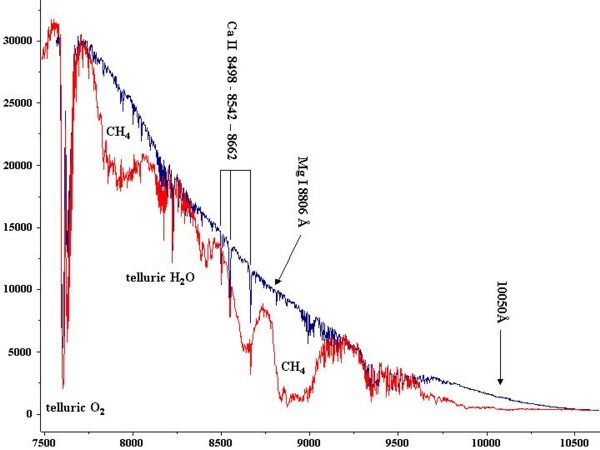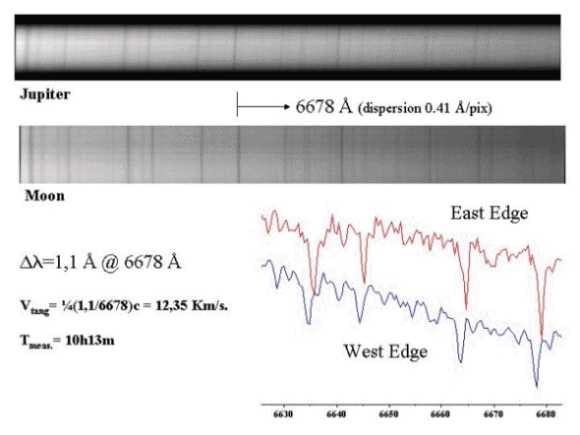SPECTRA OF PLANETS
Jupiter
- Saturn
Methane bands in the NIR spetrum of Jupiter
CCD detectors extend their sensitivity up to a wavelength of 1.1
mm (11000 Ň) that belongs to
the Near Infrared (NIR).
At these wavelength electronic transitions of atoms are quite rare, while it is possible to see overtones of the vibrational states of
molecules.
An example is given in picture 1 that shows the spectrum of the moon
(solar reflected spectrum) and of jupiter.
Among the visible features, the most prominent are due to overtones of roto-vibrational spectrum of water and oxygen in the
terrestrial atmosphere. The spectrum of jupiter shows additional absorbtions due to
methane and other compounds that Iíve not yet identified.

|
Picture 1: Comparison between the spectrum of the moon (blue) and of Jupiter (red),
recorded on dec 27th 2001 at the Cassegrain focus of an F/20 reflector.
The spectrograph was equipped with a 600 l/mm grating and a Kodak Wratten 88 filter
was used to stop the second order of visible spectrum that overlaps to the NIR spectrum.
|
Determination of rotation period of Jupiter using Doppler line shift
As it is shown in picture 2, the lines in jupiter spectrum (solar lines reflected) are
Doppler shifted toward the blue and toward the red at the opposite sides of the planet
equator due to Jupiter rotation.
This allows the determination of the tangential speed at edges and then to calculate the
period of rotation.
In the case of Jupiter, the Doppler shift is enhanced because of the high rotation speed
(9h50m on the equatorial plane).
For rotation speed much lower than the speed of light c the Doppler shift ca be calculated
by the formula Dl/l=Dv/c.
The total speed difference must be divided by 4 in order to find the real tangential equatorial
speed of Jupiter.
A factor two rises from the fact that while W edge approches, the East moves away and another
factor 2 comes from the fact that a speed V of jupiter generates an apparent speed 2V of
the source (the sun) of the reflected light.
With our data we calculate an equatorial speed of 12,35 Km/sec and thus a period of 10h13m,
slightly higher than the true value.
It is infact rather difficult to measure the doppler shift exactly at the edge of the disk,
and thus it is always a litte under-estimated.

|
|
Picture 2: Jupiter and moon spectrum at high resolution recorded on 28th jan 2002 at
the F/20 Cassegrain focus of our 0.6 m telescope.
The spectrometer slit has been aligned along the equator of Jupiter. The part of the
slit that correspond to the edges produces lines shifted toward the red or blue by the
Doppler effect due to the rotation of the planet.
The spectrograph was equipped with 1800 l/mm grating with 50 mm focusing optics and
was operated in the red to enhance resolution and Doppler shift.
|
Goto other planets:
Saturn
|
|


